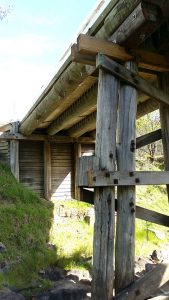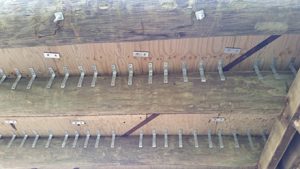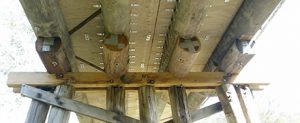Homes, buildings and infrastructure in regional areas are beginning to be rebuilt after the damage from bushfires. For many regional towns, bridges are the only ways in or out of their community. When a bridge has been damaged, the impact on the local community can be significant, particularly if the bridge is one of only a handful of access points connecting the region. Source: Timberbiz
Bridges form a vital part of Australia’s transport network with around 30,000 timber road bridges in service throughout the country. However, due to heavier and faster moving vehicles and more recently, damage by bushfires, many of these ageing timber structures have deteriorated or are damaged beyond repair. Councils need a time and budget effective solution.
As a way to extend the life of existing timber bridges or build replacement bridges, Australian timber specialist and plywood manufacturer, Big River Group, has developed an engineered timber system consisting of bridge decking, girders, headstocks and corbels along with many other engineered sections that replace existing timbers size for size.
This is a structural grade engineered plywood bridge deck system that acts as an alternative to steel and concrete decks as it is less expensive, faster to install, and critical for locations who lack council funding and need a quick response.
The system is an engineered substitute for traditional hardwood decking, it is manufactured to AS/NZS 2269-2008 from sustainable Australian plantation pine.
The key feature of the Big River Engineered Bridge Decking is that it is manufactured in continuous lengths to the full width of a bridge providing excellent load distribution using the existing structure thereby extending the life of that structure when used as a deck replacement.
When the full engineered system is used with the combination of engineered LVL: girders, headstocks and corbels etc it delivers a full bridge system that complies with loadings and AS:5100 T44 deflection limits as well as M1600.
Bridge ply offers a low-cost option for rehabilitating existing older timber structures without needing to replace the entire bridge, meaning only components that are failing need to be replaced, saving time and material costs.
Cedar Creek Bridge, in the Hunter region of New South Wales, was restored in three days – four days ahead of deadline.
The larger size of bridge ply helps to absorb much of the extra vibration of heavy vehicles while also tying together the other timber components of the bridge better than solid hardwood planks. What’s more, the material has fire resistant qualities that have the ability to withstand temperatures that reach 1000°C for up to 50 minutes.
Bridge ply can be moved in large sections with the same machinery used for alternative materials, so less trucks are required for delivery and less crane movement is needed in order to connect the components.
Additionally, as a timber-based product, most of the machinery alterations can be done on site with hand tools, such as drilling. All of these benefits, together with its lightweight material, means installation can occur in a timely manner with minimal disruption to the local community.
Big River Group is offering drop-in services and temporary bridges for immediate solutions to reconnect communities, while strengthening and recovering existing timber bridge assets quickly and within council budget.






